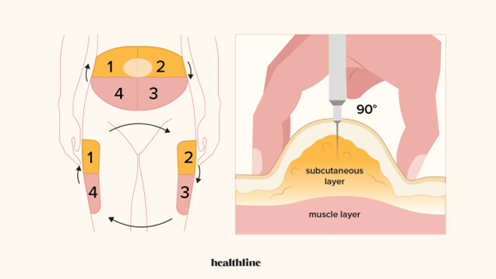The nurse is planning to discharge teaching for a client with diabetes mellitus who has a new prescription for insulin glargine. Which action should the nurse include in the discharge teaching?
Teach the client self-injection skills for daily subcutaneous administration.
Demonstrate how to select dose based on before meal blood sugar readings.
Explain to the family how to inject this medication for severe hypoglycemia.
Provide information on increasing medication dosage if ketoacidosis occurs.
The Correct Answer is A
Insulin glargine is a long-acting insulin that is given once daily at the same time every day via subcutaneous injection. Therefore, it is essential to teach the client self-injection skills for daily subcutaneous administration to ensure proper administration of insulin.
Option b is incorrect because insulin glargine is typically given at the same dose every day, not based on before meal blood sugar readings.
Option c is incorrect because insulin glargine is not used for the treatment of severe hypoglycemia, and it should not be administered by someone who is not trained to do so.
Option d is incorrect because ketoacidosis is a serious complication of diabetes mellitus that requires urgent medical atention, and increasing medication dosage is not appropriate for this condition.

Nursing Test Bank
Naxlex Comprehensive Predictor Exams
Related Questions
Correct Answer is B
Explanation
Cyclosporine is an immunosuppressive medication commonly used to prevent graft rejection after organ transplantation. St. John's Wort is known to induce cytochrome P450 enzymes, which can increase the metabolism and decrease the effectiveness of many medications, including cyclosporine. This interaction can lead to decreased plasma concentrations of cyclosporine, which can increase the risk of graft rejection. Therefore, it is important to advise the client to discontinue the use of St. John's Wort and inform their healthcare provider about any herbal or supplement use to prevent potential interactions with prescribed medications. Options a, c, and d are not directly related to the client's current condition and are not as significant as option b.

Correct Answer is D
Explanation
Ferrous sulfate is best absorbed on an empty stomach. The nurse should instruct the client to wait for 2 hours after meals before taking the tablet to promote the best absorption of the medication. The client should also be advised not to crush the enteric-coated tablets as this can affect the medication’s effectiveness.

Whether you are a student looking to ace your exams or a practicing nurse seeking to enhance your expertise , our nursing education contents will empower you with the confidence and competence to make a difference in the lives of patients and become a respected leader in the healthcare field.
Visit Naxlex, invest in your future and unlock endless possibilities with our unparalleled nursing education contents today
Report Wrong Answer on the Current Question
Do you disagree with the answer? If yes, what is your expected answer? Explain.
Kindly be descriptive with the issue you are facing.
